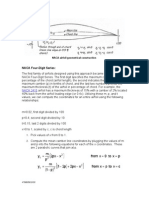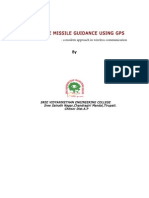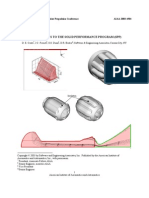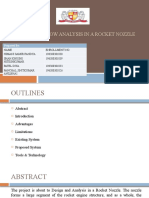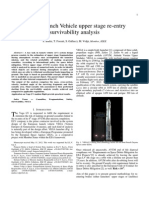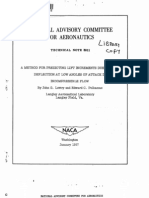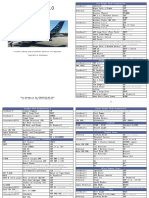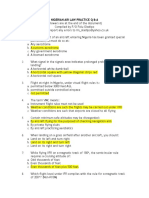Uav Propoller
Uav Propoller
Uploaded by
amir_karimiCopyright:
Available Formats
Uav Propoller
Uav Propoller
Uploaded by
amir_karimiOriginal Description:
Original Title
Copyright
Available Formats
Share this document
Did you find this document useful?
Is this content inappropriate?
Copyright:
Available Formats
Uav Propoller
Uav Propoller
Uploaded by
amir_karimiCopyright:
Available Formats
Propeller Performance Measurement for Low Reynolds
Number UAV Applications
Monal P. Merchant
*
and L. Scott Miller
Wichita State University, Wichita, Kansas 67260-0044
The recent boom in Unmanned Aerial Vehicles (UAV) and Micro Air Vehicles (MAV)
aircraft development creates a strong demand for accurate small-diameter propeller
performance data. Small-diameter propellers as defined in this paper (diameter 6 inches to
22 inches), operate at low Reynolds numbers (typically between 30,000 and 300,000),
rendering performance scaling from larger counterparts inaccurate. An Integrated
Propulsion Test System (IPTS) has been designed, developed and validated at Wichita State
University (WSU). A large number of propellers have been tested and a reliable database of
performance data has been created. This paper discusses the salient features of this
measurement system and propeller test data for a few propellers.
Nomenclature
= angle of attack
= yaw angle
A2D = analog-to-digital
CFD = computational fluid dynamics
C
T
= thrust coefficient
C
P
= power coefficient
C
Q
= torque coefficient
D = propeller diameter
IPTS = integrated propulsion test system
J = advance ratio
= freestream viscosity
n = revolutions per second
P
= propeller efficiency
= radians per second
P
P
= shaft power
q = dynamic pressure (Tunnel)
Q = torque
= freestream density
RPM = revolutions per minute
R
0.75
= radius length
R
e
= Reynolds number (Based on chord at 0.75% radius location)
R/C = radio control
T = thrust
U = freestream velocity (Corrected)
V
t
= total velocity
WOZ = wind off zero
I. Introduction
NMANNED Aerial Vehicles (UAV) and Micro Aerial Vehicles (MAV) development has boomed over the last
decade. Besides military and commercial applications, these few years have also witnessed an increase in the
U
* Graduate Research Assistant, Department of Aerospace Engineering, Box 44, Member AIAA.
Professor and Chair, Department of Aerospace Engineering, Box 44, Associate Fellow AIAA.
1
American Institute of Aeronautics and Astronautics
44th AIAA Aerospace Sciences Meeting and Exhibit
9 - 12 January 2006, Reno, Nevada
AIAA 2006-1127
Copyright 2006 by Authors. Published by the American Institute of Aeronautics and Astronautics, Inc., with permission.
number of radio controlled (R/C) airplane hobbyists and amateur R/C airplane designers. The hobby of flying R/C
airplanes is slowly turning into a professional sport with competitions not only encouraging hobbyist to improve off-
the-shelf designs but also challenging engineering students in universities to design mission specific aircraft (e.g.,
AIAA Design/Build/Fly competition). Obviously, the propulsion system directly contributes to the success of such
airplanes. In summary, the growing interests related to UAV, MAV, and R/C airplanes require the use of small-
diameter propellers and therefore creates a demand for performance data.
Although sufficient performance data for large propellers is available, it cannot typically be applied to smaller
UAV aircraft. Small-diameter UAV and model aircraft propellers operate at lower Reynolds numbers, typically
between 30,000 to 300,000 (based on chord at radius location and sea level conditions). Designers and hobbyist
have commonly relied on recommendations from layman and vendors when selecting propellers for their aircraft.
Such a situation is less than ideal and limits a UAV or R/C flyers ability to achieve consistent performance
improvements. As an aid to the designer, most engine manufacturers recommend a propeller pitch and diameter
combination that could be used with their engines.
1
But, no supporting performance or test data is made available to
the user thereby placing the recommendation in question.
One can use computational tools to predict the prospective propellers performance using theoretical and
analytical schemes, such as Computational Fluid Dynamics (CFD), Vortex methods, Blade Element Theory,
Momentum Theory or a combination thereof.
2
The principal limitation is that off-the-shelf commercially available
propellers may not be easy to model, since accurate geometry or airfoil performance data is necessary.
Unfortunately most of the off-the-shelf small-diameter propellers do not use a specific airfoil as such. A larger
variety of the wooden propellers simply have a flat bottom, cambered top cross-section, while other propellers may
use a combination of modified airfoils (http://www.apcprop.com/Engineering/engineering_design.html). In any
case, this data is not made available to the end user, thus limiting the accuracy with which performance predictions
may be attempted. A requirement for the existence of a standard experimental propeller performance database is
therefore obvious.
Although, work in this direction has been previously attempted, its progress has been limited, primarily due to
difficulties with the associated measurement systems.
3-7
Most efforts concentrated on wind tunnel testing using
complex systems and propellers with diameters larger than 24 inches.
4,5
Interestingly, the investigators
acknowledged the difficulties faced when entering the Reynolds number regimes considered in this publication.
Lastly, measurement systems used for marine propellers of similar diameter have existed, but their adaptation to
aircraft propellers has not been successful.
8
These shortcomings serve as the motivation to design and develop an
accurate measurement system, that is sufficiently sensitive, highly repeatable and caters to performance
measurements for propellers with diameters from 6 inches to 22 inches, operating in the 30,000 to 300,000 Reynolds
number regime. An obvious outgrowth is to also create a reliable propeller performance database to serve designers
and hobbyists for propeller selection.
A measurement system, using dedicated components has been designed, developed and tested at the Wichita
State University. This paper highlights the measurement system features, testing, results, and some interesting
observations.
II. Experimental Apparatus
The measurement system is divided into three sub-parts, namely, the Sensor/Motor Platform, Signal conditioning
and Power and the Data processing systems. Each sub-system is comprised of electronic instrumentation and
components as shown in Figure 1.
The 3 ft x 4 ft Low Speed Wind Tunnel at Wichita State University is an open return type capable of achieving
dynamic pressure of up to 38 psf or 1.14 x 10
6
Reynolds number per foot. Figure 2 shows a photograph of the
tunnel and lab.
The Sensor/Motor Platform is mounted on a C-Strut located inside the wind tunnel test section. The balance is a
precision 2-component instrument that measures thrust and torque and has a full scale (FS) rated output accuracy of
0.05%. The adapter that connects the motor and the load cell is designed to work with different motors, thus
allowing testing of a larger range of propeller diameters. The AstroFlights Cobalt family, electric motors are
currently being used with this setup.
1
Propeller revolution-per-minute (RPM) measurements, used for calculating Advance Ratio (J ) are recorded using
a magnetic pickup. This sensor requires a metallic tab to spin with the propeller and is capable of measuring a
maximum of 20,000 targets/s. The RPM sensor is mounted directly on the motor and its proximity to the spinning
tab is adjustable.
2
American Institute of Aeronautics and Astronautics
The 3 ft x 4 ft Low Speed Wind Tunnel facility is equipped with a pitot-static probe and a high precision 1-psid
Honeywells precision pressure transducer, having a rated output accuracy of 0.05% FS, used for measuring test-
section dynamic pressure and calculating J. The signal output from this transducer along with the propeller balance
and RPM sensor are processed through a series of signal conditioners, amplifiers and isolator modules, which are
located outside the tunnels test section. The magnetic pickup is powered by an independent 10-volt DC power
supply. The power to the motor is supplied by a high amperage/voltage precision control DC power supply.
Data acquisition is accomplished using a 16-bit analog-to-digital (A2D) board in conjunction with a Pentium
4
laptop computer. The data is collected and reduced using a self-authored Visual Basic
for Applications program
that writes the data directly to a Microsoft
Excel spreadsheet. This program completely automates the data
reduction process and is capable of configuring the A2D board. The data processing routine accounts for blockage
due to the spinning propeller as described by Glauert.
9
Non-dimentionalized propeller performance plots of thrust
coefficient (C
T
), power coefficient (C
P
), torque coefficient (C
Q
) and propeller efficiency (
P
) verses J , and a
summarized performance table, are automatically generated and archived.
Standard propulsion equations have been used to calculate non-dimensionalized performance parameters.
Amongst these are coefficients for thrust Eq. (1), coefficient for power Eq. (2), where power is determined using Eq.
(3), coefficient of torque Eq. (4) and the propeller efficiency Eq. (5). Forward velocity, propeller RPM and diameter
are combined into the Advance Ratio parameter determined using Eq. (6). The Reynolds number is calculated for
each datapoint for chord at radius location using Eq. (7), where the total velocity at radius location is given by
Eq.(8).
4 2
D n
T
C
T
=
(1)
5 3
D n
C
p
P
=
P
(2)
where,
(3) Q P
p
=
5 2
D n
C
Q
=
Q
(4)
P
T
p
C
J =
C
or
p
p
P
U T
= (5)
D n
J
U
= (6)
75 . 0
75 . 0
Re
t
=
C V
(7)
where,
( ) ( )
2
75 . 0
2
R U V
t
+ = (8)
Propeller selection (Figure 3.) for evaluation is limited only by the test section physical size and motor
availability. A few propellers were selected early in the effort to repeat runs previously conducted by Asson, for
validation and comparison purposes.
6
3
American Institute of Aeronautics and Astronautics
Balance
Signal
Amplifier
Signal
Conditioner
Power
Supply
Power
Supply
A/D
Board
Motor
INSIDE TEST SECTION
OUTSIDE TEST SECTION
Connecter
RPM Sensor
Sensor/Motor
Platform
Signal
Conditioning
and Power
Data
Processing
Pitot-Static Probe
Balance
Signal
Amplifier
Signal
Conditioner
Power
Supply
Power
Supply
A/D
Board
Motor
INSIDE TEST SECTION
OUTSIDE TEST SECTION
Connecter
RPM Sensor
Sensor/Motor
Platform
Signal
Conditioning
and Power
Data
Processing
Pitot-Static Probe
Figure 1. Measurement system block diagram.
Figure 2. 3x 4 Low Speed Wind Tunnel, Wichita State University.
4
American Institute of Aeronautics and Astronautics
Figure 3. Sample propellers that have been tested.
III. Experimental Procedure
During the experiments either the RPM or the forward velocity, or both, need to be adjusted to vary the advance
ratio and map complete performance curves. Although various combinations of RPM and velocity are possible,
varying the tunnel-q is most time efficient. Calculations based on Combined Blade Element and Momentum Theory
are used to select the required tunnel-q step sizes.
2
The motor is operated at constant power as limited by the maximum continuous current and voltage specified by
the motor manufacturer.
1
This limit is easily enforced by setting never exceed values on the power supply current
and voltage outputs.
As mentioned earlier, the data reduction routine incorporates propeller slipstream momentum corrections
9
, and
uses the resulting corrected velocity values for further performance parameter calculations.
2
Wind-off-Zero (WOZ)
readings are taken at the start and end of each run and the average WOZ values are tared from the collected data,
thus compensating for minor temperature effects that might occur during a test.
Each sensor was calibrated before using the Integrated Propulsion Test System (IPTS) for tests. The load cell
was calibrated insitu, using dead weights. A calibration apparatus that applies pure thrust and torque loads, was
specially designed and used for this purpose. The balance behavior is very linear and minimal interactions are
observed. To enhance results these interactions are accounted for in the final balance behavior matrix.
9
Although the RPM indicator calibration is not necessary, computer readings are verified using a calibrated strobe
light and a frequency counting multimeter. The tunnels q measurement transducer is calibrated and cross-checked
using a manometer.
IV. Results and Discussion
Performance data for a wide range of propellers, spanning the diameters stated in the goals, has been obtained.
Since all the data cannot be shown in this article, only a few representative results are shown for the purpose of
illustration.
The first experiments using the new apparatus were aimed towards evaluating the measurement system accuracy
and verifying its repeatability.
To establish confidence, the first experiments were similar to those conducted by Asson.
6,7
Information needed
for this purpose, such as tunnel q, and data points collected are backed out from performance plots in Assons
thesis.
6
These runs were conducted at fairly low tunnel qs and the RPM was limited to 3,000, since his apparatus
had vibrational issues.
6
The propellers examined were the 14-4, 14-6 and the 16-6 propellers belonging to the Zinger
family, with the first number indicating propeller diameter and the second number defining pitch in inches
(http://www.zingerpropeller.com/).
It should be noted that the pitch number in model or R/C aircraft terminology is
defined as the distance, in inches, a propeller would cover in one revolution.
5
American Institute of Aeronautics and Astronautics
The comparative results with Assons run (filled symbols) for the Zinger 16-6 propeller are shown in Figure 4,
with WSU IPTS results (open symbols). As is observed, data collected by the IPTS system matches that of Assons
experiment.
6
Similar results are observed for other propellers.
This experiment was repeated for all the above-mentioned propellers at similar conditions to verify WSU IPTS
data repeatability and quality. Minimal variations are observed in data collected by the IPTS as compared to Assons
data, although the variation in Assons data can be attributed to the operational limitations imposed by his apparatus.
Once the runs for Assons thesis were successfully duplicated, the apparatus installation sensitivity to tunnel
flow angularity was checked. This test was performed by comparing a baseline run at 0 pitch angle () and yaw
angle (), to runs at 3 in and respectively. The results in terms of C
Q
and C
T
versus J are shown in Figure 5a
and Figure 5b. As can be observed, C
Q
(Figure 5a) is not notably affected by changing the propeller disc plane
orientation in any direction, whereas C
T
(Figure 5b) is quite sensitive to change in pitch. However, the fact that the
result for both +3 and 3 match, suggests that any flow angularity present in the tunnel test section is
negligible.
The next tests demonstrate the WSU IPTSs ability to provide high quality repeatable data. As an example,
Figure 6 shows the performance data for two separate runs conducted using a 3-Blade, Master Air Screw 16-8
propeller. Efficiency,
P
is plotted along with C
Q
, C
T
and C
P
as a function of J . The data for these two runs,
conducted on two different days, compares well. Although only a limited amount of repeat data is shown, repeat
runs are performed for all propellers that are tested.
0 0.2 0.4 0.6 0.8 1
J
0
0.2
0.4
0.6
0.8
1
P
General Dat a Compari son
Zinger 16-6 Performance Plot s
3'x4' Wind Tunnel - Wichita State University
Efficiency
Asson's Run - Efficiency
CT
Asson's Run - CT
CQ
Asson's Run - CQ
0
0.04
0.08
0.12
0.16
0.2
C
T
0
0.004
0.008
0.012
0.016
0.02
C
Q
Figure 4. IPTS result Comparison with Assons data
6
.
6
American Institute of Aeronautics and Astronautics
7
American Institute of Aeronautics and Astronautics
0 0.2 0.4 0.6 0.8 1
J
0
0.004
0.008
0.012
0.016
0.02
C
Q
Torque Coefficient vs. Advance Ratio
3'x4' Wind Tunnel - Wichita State University
0 deg. alpha/beta
-3 deg. alpha
+3 deg. alpha
-3 deg. beta
+3 deg. beta
Figure 5a. and sweep plots of C
Q
vs. J.
0 0.2 0.4 0.6 0.8
J
1
0
0.04
0.08
0.12
0.16
0.2
C
T
Thrust Coefficient vs. Advance Ratio
3'x4' Wind Tunnel - Wichita State University
0 deg. alpha/beta
-3 deg. alpha
+3 deg. alpha
-3 deg. beta
+3 deg. beta
Figure 5b. and sweep plots of C
T
vs. J.
Interestingly, comparison runs were also performed for two geometrically similar, but different propellers made
by the same manufacturer. These tests are designed to investigate the manufacturers product reliability and the
variance in performance due to manufacturing. Contrasting results are shown in Figure 7a and Figure 7b. As can be
observed, there is a distinct variation in performance of Zinger 16-6 propellers (Figure 7a.), especially in the
efficiency and thrust coefficient, compared to a very minor variation in data of APC 16-12E propellers (Figure 7b.).
The tests discussed above help verify the setup, procedure and establish confidence in the data quality. The data
acquisition and reduction program, as mentioned previously, directly outputs four performance plots of
P
, C
Q
, C
T
and C
P
as function of J and a summary table, per test, as shown in Figure 8. For the purpose of illustration,
performance plots of a few randomly selected propellers, spanning the range of diameters covered under this project,
are shown in Figure 9 to Figure 12.
To this date over 60 propellers have been tested and their performance mapped. More propellers are being added
to this list on a regular basis. High repeatability is observed in data collected from all propellers tested using IPTS.
The system, as mentioned earlier, is well behaved.
Sensitivity and uncertainty analysis performed prior to the experiment setup and throughout the apparatus
development utilized the Kline-McClintok method.
10,11
The uncertainties in the coefficients are dependent on the
particular propeller and the advance ratio, and are typically about 0.05% in C
T
and C
Q
and about 0.003% in C
P
.
Also, as mentioned earlier, the other important observation made is that scatter in repeat run data increases as
Reynolds number decreases (e.g., when spinning the propellers below 3,000 RPM at tunnel speeds less than 50 ft/s).
As an interesting note, significant Reynolds number effects on propeller performance curves are observed, that will
be discussed in the forth-coming publications.
A web page for propeller data is planned for the near future, for more information please contact the authors.
0 0.2 0.4 0.6 0.8 1
J
0
0.2
0.4
0.6
0.8
1
P
Run 1 Efficiency
Run 2 Efficiency
Run 1 CT
Run 2 CT
Run 1 CQ
Run 2 CQ
Run 1 CP
Run 2 CP
0
0.004
0.008
0.012
0.016
0.02
C
Q
0
0.04
0.08
0.12
0.16
0.2
C
P
,
C
T
Master Air Screw 16-8 (3-Bl ade) Performance Plot s
Data Quality & Repeatabili ty
3'x4' Wind Tunnel - Wichita State University
Figure 6. Example plots illustrating data repeatability.
8
American Institute of Aeronautics and Astronautics
0 0.2 0.4 0.6 0.8 1
J
0
0.2
0.4
0.6
0.8
1
P
Prop a Efficiency
Prop b Efficiency
Prop a CT
Prop b CT
Prop a CQ
Prop b CQ
Prop a CP
Prop b CP
0
0.004
0.008
0.012
0.016
0.02
C
Q
0
0.04
0.08
0.12
0.16
0.2
C
P
,
C
T
Zinger 16-6 Prop-a & Prop-b
Simi lar propell er compari son
3'x4' Wind Tunnel - Wichita State University
Figure 7a. Example plots illustrating performance variation for two
separate Zinger 16-6 propellers.
0 0.2 0.4 0.6 0.8 1
J
0
0.2
0.4
0.6
0.8
1
P
Prop a Efficiency
Prop b Efficiency
Prop a CT
Prop b CT
Prop a CQ
Prop b CQ
Prop a CP
Prop b CP
0
0.004
0.008
0.012
0.016
0.02
C
Q
0
0.04
0.08
0.12
0.16
0.2
C
P
,
C
T
APC 16-12E Prop-a & Prop-b
Simi lar propell er comparison
3'x4' Wind Tunnel - Wichita State University
Figure 7b. Example plots illustrating performance variation for two
separate APC 16-12E propellers.
9
American Institute of Aeronautics and Astronautics
0 0.4 0.8 1.2
J
0
0.2
0.4
0.6
0.8
1
P
Efficiency
CQ
CP
CT
0
0.004
0.008
0.012
0.016
0.02
C
Q
0
0.0
0.0
0.1
0.1
0.2
C
P
,
C
T
APC 12-12E Propell er
Propell er Performance Chart
3'x4' Wind Tunnel - Wichita State University
M
2
SUMMARY
PROP EAPC DIA 12 PITCH 12
q(psf) U (ft/s) T (lb) Q (in-lb) RPM
0.07 6.90 3.10 3.90 6,323
0.42 17.95 2.75 3.70 6,131
2.32 43.71 2.77 3.67 6,304
3.25 51.89 2.72 3.82 6,431
4.41 60.65 2.47 3.76 6,398
5.78 69.60 2.29 3.76 6,431
8.37 83.92 1.94 3.67 6,533
11.10 96.82 1.56 3.46 6,641
13.42 106.56 1.24 3.24 6,833
16.35 117.70 0.81 2.82 7,069
J P CT CP CQ Re0.75
0.07 0.10 0.1187 0.0781 0.0124 90,370
0.18 0.25 0.1117 0.0787 0.0125 87,860
0.42 0.60 0.1064 0.0740 0.0118 91,495
0.48 0.66 0.1004 0.0738 0.0118 93,845
0.57 0.72 0.0924 0.0735 0.0117 94,069
0.65 0.76 0.0846 0.0727 0.0116 95,349
0.77 0.78 0.0696 0.0687 0.0109 98,233
0.87 0.75 0.0542 0.0628 0.0100 101,239
0.94 0.69 0.0407 0.0555 0.0088 105,054
1.00 0.55 0.0247 0.0452 0.0072 109,706
Figure 8. Data reduction code output file example.
0 0.2 0.4 0.6 0.8 1
J
0
0.2
0.4
0.6
0.8
1
CT
CQ
CP
0
0.004
0.008
0.012
0.016
0.02
C
Q
0
0.04
0.08
0.12
0.16
0.2
C
P
,
C
T
Zi nger 22-8 Propeller
Example - Propeller Performance Plot
3'x4' Wind Tunnel - Wichita State University
Figure 9. Example Performance plots for Zinger 22-8 propeller.
10
American Institute of Aeronautics and Astronautics
0 0.2 0.4 0.6 0.8 1
J
0
0.2
0.4
0.6
0.8
1
CT
CQ
CP
0
0.004
0.008
0.012
0.016
0.02
C
Q
0
0.04
0.08
0.12
0.16
0.2
C
P
,
C
T
APC 16-12E
Exampl e - Propell er Performance Pl ot
3'x4' Wind Tunnel - Wichita State University
Figure 10. Example Performance plots for APC 16-12E propeller
0 0.2 0.4 0.6 0.8 1
J
0
0.2
0.4
0.6
0.8
1
CT
CQ
CP
0
0.004
0.008
0.012
0.016
0.02
C
Q
0
0.04
0.08
0.12
0.16
0.2
C
P
,
C
T
APC 8.8-8.75 Propeller
Exampl e - Propell er Performance Pl ot
3'x4' Wind Tunnel - Wichita State University
Figure 11. Example Performance plots for APC 8.8-8.75 propeller
11
American Institute of Aeronautics and Astronautics
0 0.2 0.4 0.6 0.8 1
J
0
0.2
0.4
0.6
0.8
1
CT
CQ
CP
0
0.004
0.008
0.012
0.016
0.02
C
Q
0
0.0
0.0
0.1
0.1
0.2
C
P
,
C
T
Rev-Up 12-8 Propeller
Example - Propeller Performance Plot
3'x4' Wind Tunnel - Wichita State University
Figure 12. Example Performance plots for Rev-Up 12-8 propeller
V. Conclusions
A need for small-diameter propeller performance data, for low Reynolds number UAV, MAV, and R/C hobby
aircraft applications, exists. A new test apparatus has been developed to address this need. The following
conclusions are offered based on the projects results and the observations:
The goal of designing and developing an accurate measurement system has been met
A reliable propeller performance database has been created and new data is being added on a regular
basis
Results from the sensitivity and repeatability studies affirm the measurement systems reliability
The apparatus is very sturdy and its sensitivity and repeatability is not affected at high motor RPM and
tunnel speeds
Lastly, the low uncertainties in measurements increase confidence in data
The tests conducted so far also demonstrate the systems time efficiency. An entire experiment can be completed
within ten to fifteen minutes. Additionally, the ability to quickly change propellers or motors greatly reduces wind
tunnel occupancy time, which can prove very valuable.
A website is under preparation for public access to the propeller performance data. Moreover, this system will be
a valuable experimental tool for investigators to not only measure and determine propeller performance
experimentally, but to also gain insight needed to further improve or optimize small-diameter propellers.
Acknowledgments
The authors would like to thank the department of Aerospace Engineering and the Wichita State University for
their support in these efforts. Special acknowledgment also goes to the help extended by Philip Butler and J oshua
Nelson.
References
1
Boucher, B., Electric Motor Handbook, 3
rd
Print, 2001, Chaps. 1, 2, 9.
2
Seddon, J . and Newman, S., Basic Helicopter Aerodynamics, 2
nd
ed., AIAA Education Series, VA, 2001, Chaps. 2, 3.
3
Bass, R. M., Techniques of Model Propeller Testing, SAE Paper 83-0750, April 1983.
12
American Institute of Aeronautics and Astronautics
4
Bass, R. M., Small Scale Wind Tunnel Testing of Model Propellers, 24
th
Aerospace Sciences Meeting, AIAA-86-0392,
J anuary 1986.
5
Stefko, G. L., Bober, L. J . and Neumann, H. E., New Test Techniques and Analytical Procedures for Understanding the
Behavior of Advanced Propellers, SAE Paper 83-0729, April 1983.
6
Asson, K. M., The Development of an Advanced Dynamometer System to Experimentally Determine Propeller
Performance, M.S. Thesis, University of Notre Dame, Notre Dame, IN, 1990.
7
Asson, K. M. and Dunn, P. F., Compact Dynamometer System that can Accurately Determine Propeller Performance,
Journal of Aircraft, Vol. 29, No. 1, 1992, pp. 8-9.
8
Molland, A. F. and Turnock, S. R., A Propeller Thrust and Torque Dynamometer for Wind Tunnel Models, Strain,
Blackwell Sciences Ltd., Vol. 38, 2002, pp. 3-10.
9
Pope A., Wind Tunnel Testing, 2
nd
ed., J ohn Wiley, New York, 1954, Chaps. 6.
10
Kline, S. J . and McClintok, F. A., Describing Uncertainties in Single Sample Experiment, Mechanical Engineering, Vol.
75, No. 1, 1953, pp. 3-9.
11
Holman, J . P., Experimental Methods for Engineers, 6
th
ed., McGraw Hill, New York, 1994, Chaps. 3.
13
American Institute of Aeronautics and Astronautics
You might also like
- Airbus Repair and Design Approval Form: 9. Title: 10. Damage / Request DescriptionDocument4 pagesAirbus Repair and Design Approval Form: 9. Title: 10. Damage / Request Descriptionalagu vairamuthu50% (2)
- X-Winder TriFold BrochureDocument2 pagesX-Winder TriFold BrochureSwamy RakeshNo ratings yet
- 2d MLN NozzleDocument86 pages2d MLN NozzleP K100% (1)
- The Tandem Wing Concept Applied To Modern TransportsDocument2 pagesThe Tandem Wing Concept Applied To Modern Transportscatalina mazo50% (2)
- ME 554 Problem Set-04 Nozzle Theory-Part-2Document1 pageME 554 Problem Set-04 Nozzle Theory-Part-2rahul prakashNo ratings yet
- DTA Guidelines For Antenna InstallationsDocument60 pagesDTA Guidelines For Antenna InstallationsivanfernandorodriguezNo ratings yet
- EMIRATES AIRLINES Marketing and BusinessDocument15 pagesEMIRATES AIRLINES Marketing and BusinessRiezal BintanNo ratings yet
- Small Unmanned Aircraft: Theory and PracticeFrom EverandSmall Unmanned Aircraft: Theory and PracticeRating: 4.5 out of 5 stars4.5/5 (2)
- 3D Choke RingDocument6 pages3D Choke RingPraba Karan DNo ratings yet
- Stall Delay of Two-Wing Configurations With Decalage at Low Reynolds NumbersDocument6 pagesStall Delay of Two-Wing Configurations With Decalage at Low Reynolds NumbersHassan raza100% (1)
- Introduction To Glider Flight - Part 2Document21 pagesIntroduction To Glider Flight - Part 2afghanputeh100% (1)
- Low-Reynolds-Number Airfoil DesignDocument9 pagesLow-Reynolds-Number Airfoil Designamir_karimiNo ratings yet
- A New Planar Dual-Band GPS Antenna Designed For Reduced Susceptibility To Low-Angle MultipathDocument9 pagesA New Planar Dual-Band GPS Antenna Designed For Reduced Susceptibility To Low-Angle MultipathJon Himes100% (1)
- NACA AirfoilDocument3 pagesNACA Airfoilmmaggiore3No ratings yet
- Uav Monopulse AntennaDocument7 pagesUav Monopulse AntennaognianovNo ratings yet
- Catapult SystemDocument7 pagesCatapult Systemandrew munyiva0% (1)
- Micro Air VehicleDocument186 pagesMicro Air Vehiclebinho58100% (1)
- Winglet Airfoil Maughmer Et AlDocument8 pagesWinglet Airfoil Maughmer Et Alzaid100% (1)
- Micro UAVDocument8 pagesMicro UAVMOST PASONNo ratings yet
- Ramjet EquationsDocument8 pagesRamjet EquationsBECOME POPULAR100% (1)
- Design and Testing of An Autorotative Payload Delivery SystemDocument11 pagesDesign and Testing of An Autorotative Payload Delivery SystemvictorNo ratings yet
- UavDocument11 pagesUavAthul MuraliNo ratings yet
- Uav System DesignDocument7 pagesUav System DesignFIGHTER WINGS AVIATION COLLEGENo ratings yet
- Youngblood 2015Document222 pagesYoungblood 2015Vicente Alvero ZambranoNo ratings yet
- Formation of Explosively Formed Penetrator With Fins and Its Flight CharacteristicsDocument5 pagesFormation of Explosively Formed Penetrator With Fins and Its Flight CharacteristicsKidus Yado GirmaNo ratings yet
- UAV Guidance & ControlDocument31 pagesUAV Guidance & ControlAviation/Space History Library100% (1)
- Kinetic Launcher For UAVDocument13 pagesKinetic Launcher For UAVLord Vario100% (1)
- Ijm&sv12n1 12Document14 pagesIjm&sv12n1 12ram_unltd1518No ratings yet
- SRM - Xls S R M: PerformanceDocument29 pagesSRM - Xls S R M: PerformanceDario Alberto Rodriguez MorocoimaNo ratings yet
- Aerospike ReportDocument22 pagesAerospike ReportAromalSPillai100% (1)
- UAV Aerodyanamic DesignDocument14 pagesUAV Aerodyanamic DesignDarío RdrgzNo ratings yet
- Techniques For Measurement of Dynamic Stability Derivatives in Ground Test FacilitiesDocument236 pagesTechniques For Measurement of Dynamic Stability Derivatives in Ground Test FacilitieseeebbbuuuNo ratings yet
- 99 Terzic - ZecevicDocument17 pages99 Terzic - Zecevicae00505No ratings yet
- Guidance and Control of Artillery ProjectileDocument8 pagesGuidance and Control of Artillery Projectilescorpion_l_81No ratings yet
- Modes Indicate Cracks in Wind Turbine BladesDocument5 pagesModes Indicate Cracks in Wind Turbine BladestylerdurdaneNo ratings yet
- Laboratory EquipmentDocument9 pagesLaboratory EquipmentFaiq AhmadNo ratings yet
- Adaptive Missile Guidance Using GpsDocument9 pagesAdaptive Missile Guidance Using Gpsjamesyblee100% (1)
- Resources For Swarm RobotsDocument3 pagesResources For Swarm RobotsShivam KapoorNo ratings yet
- The Science of Ballistics: Mathematics Serving The Dark SideDocument14 pagesThe Science of Ballistics: Mathematics Serving The Dark SideKidus Yado GirmaNo ratings yet
- Aerodynamics of Spin Stabilised MissilesDocument23 pagesAerodynamics of Spin Stabilised MissilesAries SattiNo ratings yet
- Monocopter Report FinalDocument24 pagesMonocopter Report FinalAnshul KhandelwalNo ratings yet
- Improvements To The Solid Performance ProgramDocument19 pagesImprovements To The Solid Performance ProgramtenggoNo ratings yet
- TOW - Tube-Launched - Optically Tracked - Wire-Guided Missle Rocket MotorDocument1 pageTOW - Tube-Launched - Optically Tracked - Wire-Guided Missle Rocket MotorhdslmnNo ratings yet
- Aerodynamics Drag of A Two-Dimensional External Compression Inlet at Supersonic SpeedDocument154 pagesAerodynamics Drag of A Two-Dimensional External Compression Inlet at Supersonic SpeedSumanth VarmaNo ratings yet
- Guidance and Control of Cannon Launched Guided Projectile-MorrisonDocument7 pagesGuidance and Control of Cannon Launched Guided Projectile-MorrisonvaskarthikeyanNo ratings yet
- Motore p80 75Document4 pagesMotore p80 75aminardakaniNo ratings yet
- Efl5550 Manual enDocument18 pagesEfl5550 Manual endanielNo ratings yet
- Antenna Pattern Characterization of The Low-Frequency Receptor of LOFAR by Means of An UAV-mounted Artificial Test SourceDocument11 pagesAntenna Pattern Characterization of The Low-Frequency Receptor of LOFAR by Means of An UAV-mounted Artificial Test SourceSudung SitumorangNo ratings yet
- Trimble TRM59900 Ti-Choke Ring GNSS Antenna Test ReportDocument7 pagesTrimble TRM59900 Ti-Choke Ring GNSS Antenna Test ReportAkiraTsaiNo ratings yet
- Canard 5Document29 pagesCanard 5Orhan Hızalan100% (1)
- Linear Aerospike SR-71 Experiment (LASRE) : Aerospace Propulsion Hazard Mitigation SystemsDocument21 pagesLinear Aerospike SR-71 Experiment (LASRE) : Aerospace Propulsion Hazard Mitigation SystemsGibran GarnicaNo ratings yet
- P-15 Termit: Anti-Ship Missile Soviet UnionDocument4 pagesP-15 Termit: Anti-Ship Missile Soviet UnionJuan Gomez GomezNo ratings yet
- Structural Integrity Assessment On Solid Propellant Rocket MotorsDocument75 pagesStructural Integrity Assessment On Solid Propellant Rocket MotorsAzeem KhanNo ratings yet
- Design of Helical Antennas For 433 MHZ Radio Telemetry Ground Station and Uav (Unmanned Aerial Vehicle)Document7 pagesDesign of Helical Antennas For 433 MHZ Radio Telemetry Ground Station and Uav (Unmanned Aerial Vehicle)Tiara Nira SariNo ratings yet
- Effect of Motor Length and Propellant Formulation On Nozzle Less Solid Rocket PerformanceDocument11 pagesEffect of Motor Length and Propellant Formulation On Nozzle Less Solid Rocket PerformanceSofyan Natsir100% (2)
- F2-BP-2019-Malek-Michal-Bachelor Thesis - Michal MalekDocument46 pagesF2-BP-2019-Malek-Michal-Bachelor Thesis - Michal Malekjoez04No ratings yet
- Rocket NozzleDocument9 pagesRocket NozzleNainan TrivediNo ratings yet
- Team Pioneer: Kevin Gu, James Leet, Amit Alon, Manpreet Singh June 7, 2012Document23 pagesTeam Pioneer: Kevin Gu, James Leet, Amit Alon, Manpreet Singh June 7, 2012aloksahu1No ratings yet
- 6C33CB (1) HybDocument9 pages6C33CB (1) HybLê Thiên ThanhNo ratings yet
- Vega PDFDocument7 pagesVega PDFMihaela NastaseNo ratings yet
- Naca TN 3911Document30 pagesNaca TN 3911teuapNo ratings yet
- Military Laser Technology for Defense: Technology for Revolutionizing 21st Century WarfareFrom EverandMilitary Laser Technology for Defense: Technology for Revolutionizing 21st Century WarfareNo ratings yet
- Design of 9.2 7 I - Pressure-RatioDocument35 pagesDesign of 9.2 7 I - Pressure-Ratioamir_karimiNo ratings yet
- Diffuser PerformanceDocument15 pagesDiffuser Performanceamir_karimiNo ratings yet
- Vaneless DiffuserDocument8 pagesVaneless Diffuseramir_karimiNo ratings yet
- Design and Development of Micro TurbineDocument36 pagesDesign and Development of Micro TurbineFRENDANo ratings yet
- Ada 320213Document69 pagesAda 320213amir_karimiNo ratings yet
- The NRL Mite Air VehicleDocument14 pagesThe NRL Mite Air Vehicleamir_karimiNo ratings yet
- Potsdam1 AHS04Document13 pagesPotsdam1 AHS04amir_karimiNo ratings yet
- XFLR5 HandoutDocument6 pagesXFLR5 HandoutOdair ProphetaNo ratings yet
- Basic Design of Flying Wing ModelsDocument32 pagesBasic Design of Flying Wing ModelsVignesh SelvarajNo ratings yet
- Single Aisle Technical Training Manual CMQ A330/A340 To A319/320/321 (IAE V2500/ME) T1 (LVL 2&3) DoorsDocument84 pagesSingle Aisle Technical Training Manual CMQ A330/A340 To A319/320/321 (IAE V2500/ME) T1 (LVL 2&3) DoorsjuanNo ratings yet
- CD CM OverridesDocument51 pagesCD CM OverridesSai SushankNo ratings yet
- FL 760aDocument16 pagesFL 760aStephen KayeNo ratings yet
- Como Hacer Globos de Papel PDFDocument16 pagesComo Hacer Globos de Papel PDFCarlos Luis GonzalezNo ratings yet
- Airbus A310 ChecklistDocument4 pagesAirbus A310 ChecklistJonathan NoriegaNo ratings yet
- Hancock Taj1985Document21 pagesHancock Taj1985nanjappa hebbaleNo ratings yet
- Macross 2 Metal SirenDocument5 pagesMacross 2 Metal SirenRobert Best100% (3)
- Aiaa 2022 4015Document14 pagesAiaa 2022 4015steve yangNo ratings yet
- CAB Revised Fees and Charges (Dec 2013)Document4 pagesCAB Revised Fees and Charges (Dec 2013)PortCallsNo ratings yet
- Oman AirDocument3 pagesOman AirMLR123No ratings yet
- Flat PlateDocument11 pagesFlat PlateChegrani AhmedNo ratings yet
- Winglets Design IIDocument12 pagesWinglets Design IIGabriel Rodrigues Felix100% (1)
- AVIM 105A and 106A Combustion Heater Operation and MaintenanceDocument13 pagesAVIM 105A and 106A Combustion Heater Operation and Maintenance13594No ratings yet
- 1-Piece Instrumentation, 40G and 40 Series: Part NoDocument2 pages1-Piece Instrumentation, 40G and 40 Series: Part Nozidanejason8No ratings yet
- 2-NigerianAirLawPractiseQuestions - Edited 2Document26 pages2-NigerianAirLawPractiseQuestions - Edited 2OFONMBUK IDIONGNo ratings yet
- Rekap Trainee APU GTCP331-350 Fam 09 01 2023Document2 pagesRekap Trainee APU GTCP331-350 Fam 09 01 2023Rinti ArnoNo ratings yet
- Gas Dynamic Resonance Ignition For Repetitive StartsDocument8 pagesGas Dynamic Resonance Ignition For Repetitive StartsBrunno VasquesNo ratings yet
- Dynamic Modeling and Simulation of Satellite Thermal Control SystemDocument4 pagesDynamic Modeling and Simulation of Satellite Thermal Control SystemNavjeet SinghNo ratings yet
- CE261 DYNAMICS-Problems Fall 2010Document23 pagesCE261 DYNAMICS-Problems Fall 2010Visminda Sebastian0% (1)
- Airworthiness Directive: Design Approval Holder's Name: Type/Model Designation(s)Document4 pagesAirworthiness Directive: Design Approval Holder's Name: Type/Model Designation(s)ErculesNo ratings yet
- Weight and Balance PDFDocument52 pagesWeight and Balance PDFtumbNo ratings yet
- Agarvanshi Aluminium LTDDocument60 pagesAgarvanshi Aluminium LTDSaurabh KumarNo ratings yet
- HondaJet Elite BrochureDocument9 pagesHondaJet Elite Brochurelegoulu21100% (1)
- AIC - A318 - A319 - A320 - A321 - TSM - 01-Feb-2024 - 35-10-00-810-821-A - REGUL LO PR Indication On The DOOR - OXY PageDocument8 pagesAIC - A318 - A319 - A320 - A321 - TSM - 01-Feb-2024 - 35-10-00-810-821-A - REGUL LO PR Indication On The DOOR - OXY PageDebasis RoyNo ratings yet
- Asymmetric FlightDocument11 pagesAsymmetric Flightpei3721No ratings yet
- Annex 262 AU1630Document2 pagesAnnex 262 AU1630Rakshit DholariaNo ratings yet













